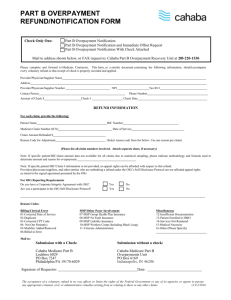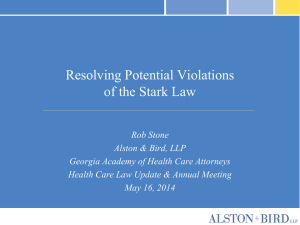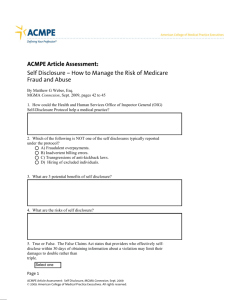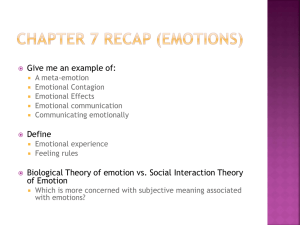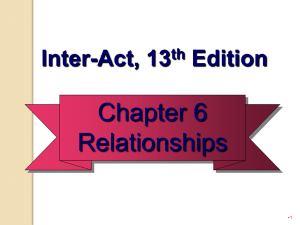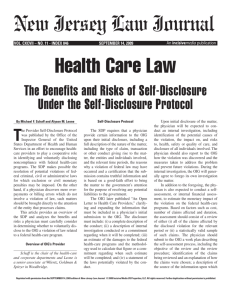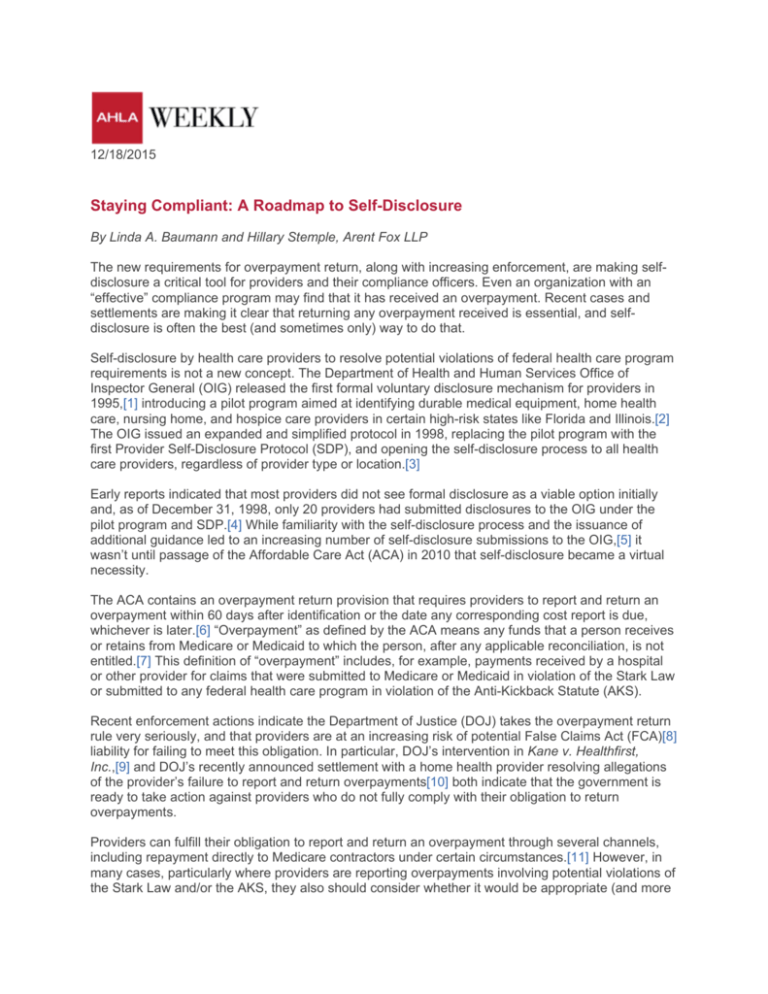
12/18/2015
Staying Compliant: A Roadmap to Self-Disclosure
By Linda A. Baumann and Hillary Stemple, Arent Fox LLP
The new requirements for overpayment return, along with increasing enforcement, are making selfdisclosure a critical tool for providers and their compliance officers. Even an organization with an
“effective” compliance program may find that it has received an overpayment. Recent cases and
settlements are making it clear that returning any overpayment received is essential, and selfdisclosure is often the best (and sometimes only) way to do that.
Self-disclosure by health care providers to resolve potential violations of federal health care program
requirements is not a new concept. The Department of Health and Human Services Office of
Inspector General (OIG) released the first formal voluntary disclosure mechanism for providers in
1995,[1] introducing a pilot program aimed at identifying durable medical equipment, home health
care, nursing home, and hospice care providers in certain high-risk states like Florida and Illinois.[2]
The OIG issued an expanded and simplified protocol in 1998, replacing the pilot program with the
first Provider Self-Disclosure Protocol (SDP), and opening the self-disclosure process to all health
care providers, regardless of provider type or location.[3]
Early reports indicated that most providers did not see formal disclosure as a viable option initially
and, as of December 31, 1998, only 20 providers had submitted disclosures to the OIG under the
pilot program and SDP.[4] While familiarity with the self-disclosure process and the issuance of
additional guidance led to an increasing number of self-disclosure submissions to the OIG,[5] it
wasn’t until passage of the Affordable Care Act (ACA) in 2010 that self-disclosure became a virtual
necessity.
The ACA contains an overpayment return provision that requires providers to report and return an
overpayment within 60 days after identification or the date any corresponding cost report is due,
whichever is later.[6] “Overpayment” as defined by the ACA means any funds that a person receives
or retains from Medicare or Medicaid to which the person, after any applicable reconciliation, is not
entitled.[7] This definition of “overpayment” includes, for example, payments received by a hospital
or other provider for claims that were submitted to Medicare or Medicaid in violation of the Stark Law
or submitted to any federal health care program in violation of the Anti-Kickback Statute (AKS).
Recent enforcement actions indicate the Department of Justice (DOJ) takes the overpayment return
rule very seriously, and that providers are at an increasing risk of potential False Claims Act (FCA)[8]
liability for failing to meet this obligation. In particular, DOJ’s intervention in Kane v. Healthfirst,
Inc.,[9] and DOJ’s recently announced settlement with a home health provider resolving allegations
of the provider’s failure to report and return overpayments[10] both indicate that the government is
ready to take action against providers who do not fully comply with their obligation to return
overpayments.
Providers can fulfill their obligation to report and return an overpayment through several channels,
including repayment directly to Medicare contractors under certain circumstances.[11] However, in
many cases, particularly where providers are reporting overpayments involving potential violations of
the Stark Law and/or the AKS, they also should consider whether it would be appropriate (and more
advantageous) to return the overpayment by self-disclosing to the OIG, the Centers for Medicare &
Medicaid Services (CMS), or DOJ. Unlike DOJ, the OIG and CMS each have formal protocols that
must be followed to self-disclose. This article provides an overview of these options and their
potential benefits, limitations, and requirements.
The Decision to Disclose
Determining That There Is an Overpayment
Once a compliance concern is raised, the decision to disclose ideally should not be made until there
has been a full investigation of the facts and a comprehensive review of the applicable law to
determine whether an overpayment actually has been “identified.” The investigation should be
directed by legal counsel to ensure that the investigation is privileged. It also may be necessary for
counsel to engage consultants to help them evaluate the facts, e.g., if the matter involves
overcoding.
Unfortunately, in some cases, it may be almost impossible to conduct a comprehensive review within
the 60-day time period. Nevertheless, the Kane decision indicates that court’s view that an
overpayment is identified fairly early in the process,[12] although that decision may be limited to
some extent by its particular facts. In any event, regulations on the obligation to return overpayments
reportedly are about to be finalized and may provide some additional guidance.[13]
For purposes of this article, we assume that a provider has determined there is an overpayment that
needs to be returned, and the 60-day period has not expired.
Potential Benefits of Self-Disclosure
If an overpayment needs to be returned, there are several benefits to self-disclosure, as described in
more detail below. First, the amount to be repaid to the government likely will be much lower.
Second, the government is unlikely to impose a costly Corporate Integrity Agreement (CIA) against a
self-disclosing entity. Depending on the type of disclosure, the provider likely will receive one or
more types of releases that will protect it from certain types of potential liability. In addition, if a selfdisclosure is successfully concluded, the government is less likely to conduct its own, far more
intrusive, investigation.
Potential Risks of Self-Disclosure
While returning an overpayment to a Medicare Administrative Contractor (MAC) is usually the
easiest (and least expensive) way to proceed, this approach is not always viable, and a more formal
self-disclosure will be necessary. However, self-disclosure involves inherent risks. For example, the
government may not limit its review to the facts and issues raised in the disclosure. They may decide
to conduct their own investigation and significantly expand the ultimate scope of liability. Further, if
the government finds other overpayments that were not part of the self-disclosure, it may well lead to
questions about why the provider did not identify these additional issues, which in turn could raise
questions about the provider’s intent. If the government investigation indicates that the provider
limited the scope of the self-disclosure when the provider knew, or should have known, that there
were other related issues, the potential liability could increase dramatically.
In addition, the self-disclosure protocols provide no guarantees of leniency, immunity, or specific
benefits. Providers may not be accepted into the OIG or CMS protocols. Even when the disclosures
are accepted, the ultimate sanctions that will be imposed are not guaranteed. In 2013, the OIG
revised its SDP to provide general guidelines, giving providers a general idea of the type of
resolution to expect upon disclosure. CMS has never provided comparable guidelines in connection
with its Self-Referral Disclosure Protocol (SRDP), and there is no public guidance available about
the benefits of self-disclosure to DOJ. Also, self-disclosure to one government agency may or may
not resolve potential liability to another, and the impact of self-disclosure on qui tam complaints filed
under the federal False Claims Act also is unclear.[14]
Some self-disclosures can take a significant amount of time to resolve. The OIG has made an effort
to expedite the process under its SDP but some disclosures to CMS have been in process for
several years. However, while most providers likely would prefer to resolve the situation as
expeditiously as possible, the delay should not create additional exposure under the overpayment
return provision since both the OIG and the CMS protocols indicate that the 60-day period for
overpayment return is likely tolled pending resolution of the self-disclosure.
Finally, many aspects of the fraud and abuse laws are unclear and it may not always be possible to
determine with absolute certainty that an overpayment has been “identified.” There may be an
overpayment under one interpretation of the law but not necessarily under another. Obviously the
risk here is that the provider self-discloses when there really was no overpayment. Despite these
risks, the question usually becomes not whether to disclose, but to whom.
Potential Avenues of Disclosure
Disclosure to the OIG
Self-disclosure to the OIG generally has become a well-established process. While there was some
initial reluctance to utilize the SDP, in 2012 the OIG reported that during the first 14 years of the
protocol, more than 800 disclosures had been resolved, resulting in recovery of more than $280
million.[15]
On April 17, 2013, the OIG posted a revised SDP.[16] While the SDP retained many of the original
elements of the initial protocol, it also included new notable features including requiring minimum
settlement amounts of at least $50,000 for self-disclosures involving kickback-related submissions
and $10,000 for all other disclosures. Importantly, the revised SDP also provides much more detail
on the OIG’s review and resolution process, and the benefits providers obtain from disclosing
through the SDP.
Eligibility Requirements
All health care providers, suppliers, or other individuals or entities subject to the OIG’s civil monetary
penalty (CMP) authorities are eligible to use the SDP. This includes physicians, hospitals, and other
facilities, as well as pharmaceutical or medical device manufacturers. Disclosing parties already
subject to a government inquiry are not automatically prohibited from using the SDP, but disclosures
by such parties must be made in good faith and must not be an attempt to circumvent the ongoing
inquiry.[17]
The SDP is available to resolve matters that in the disclosing party’s reasonable assessment,
“potentially violate Federal criminal, civil, or administrative laws for which CMPs are authorized.”[18]
For example, the SDP can be used to resolve potential violations of the AKS.[19] The disclosing
party must:
explicitly identify the laws that were potentially violated and acknowledge there is a potential
violation;
take corrective action and end the potential conduct at issue within 90 days of submission to
the SDP;
perform an initial investigation and damages audit within three months of acceptance into the
SDP by the OIG; and
submit a disclosure including all other information stipulated in the SDP.[20]
The SDP is not available for disclosure of an arrangement that involves only liability under the Stark
Law.[21] Disclosures that only implicate the Stark Law must be submitted to CMS through the
SRDP. However, an arrangement that potentially violates both the AKS and the Stark Law may be
submitted through the SDP.
The SDP also is not available for a matter not involving a potential violation of federal criminal, civil,
or administrative law for which CMPs are authorized, such as a matter exclusively involving
overpayments or errors.[22] Finally, the SDP cannot be used to obtain an opinion from the OIG
regarding whether an actual or potential violation has occurred. Such inquiries are to be submitted
through the OIG’s Advisory Opinion process.
Benefits of the SDP
First, the OIG has the authority to release a provider from any claims or causes of action the OIG
may have against the provider under the Civil Monetary Penalties law, including release for
permissive exclusion based on fraud, kickbacks, and other prohibited activities.
Second, the OIG protocol states that providers who cooperate during the SDP process are entitled
to pay a lower multiplier on single damages than is typically required in government-initiated
investigations. While the multiplier accepted in each case will vary depending on the facts and
circumstances, the OIG’s general practice is to require a multiplier of 1.5 times single damages.[23]
This multiplier is half of the treble damages that can result if a provider does not disclose through the
SDP and the potentially fraudulent behavior is later discovered. Further, damages for disclosures
submitted to resolve potential AKS and Stark Law violations are calculated based on the amount of
remuneration involved in each arrangement rather than the amount of reimbursement received,
which can substantially reduce exposure.
Third, absent extenuating circumstances, providers disclosing through the SDP will not be required
to enter into a CIA with the OIG.[24] Since CIAs are costly and extremely time-consuming, avoiding
the imposition of a CIA can be extremely advantageous.
Fourth, as a practical matter, submission through the SDP may toll the 60-day period for return of an
overpayment pending resolution of the self-disclosure.[25]
Finally, the OIG has streamlined its internal processes to reduce the average time a case is pending
to less than 12 months from acceptance into the SDP.[26]
Limitations of the SDP
The OIG does not have the authority to release providers from potential False Claims Act liability.
Moreover, while the OIG will consult with DOJ on civil and criminal matters, DOJ may decide not to
join in the SDP process and/or provide an additional release for False Claims Act liability. As a
result, complex cases, particularly those at risk for qui tam actions under the False Claims Act may
not be fully resolved by disclosure under the SDP. Further, the SDP notes that if DOJ participates in
the process, the disclosure will be resolved “as DOJ determines is appropriate,” i.e., the settlement
amount may well increase.[27]
SDP Submissions to the OIG
Providers need to carefully read and follow all submission requirements when self-disclosing to the
OIG. A checklist of the requirements for SDP submissions, as well as a brief description of the
submission process, is included at Appendix A.
Disclosure to CMS
The ACA provided for the establishment of a voluntary self-disclosure protocol for disclosure of
actual or potential violations of the Stark Law. Specifically, Section 6409 of the ACA required the
Secretary of the Department of Health and Human Services (HHS) to establish a Medicare protocol
describing the process for providers to self-disclose actual or potential violations of the Stark Law.
Many providers lobbied for such a protocol because the Stark Law is a strict liability statute and
relatively minor actions could lead to substantial exposure.
The problem was compounded by the fact that the measure of damages in a Stark case involves the
amount of reimbursement received for all referrals by a physician to the provider during the time that
a given financial relationship does not comply with the applicable Stark exception. As a practical
matter, the potential damages in a case involving a violation of the Stark Law usually far exceed the
potential liability in an AKS case where damages are measured by the amount of improper
remuneration provided to the referral source. To help address this issue, Section 6409(b) of the ACA
granted the Secretary of HHS the authority to reduce the amount due for violations of the Stark Law.
CMS has currently implemented a disclosure protocol for (i) a Stark Law-only violation, i.e., the CMS
Voluntary Self-Referral Disclosure Protocol;[28] and (ii) an expedited process that can be used for
one specific type of Stark Law violation, i.e., the Physician Self-Referral Disclosure Protocol—
Special Instructions for Violations of 42 C.F.R. § 411.362(b)(3)(ii)(C) (the “Abbreviated
Protocol”).[29] In the vast majority of cases, providers will have to disclose using the process
described in the standard SRDP. The Abbreviated Protocol only applies to a relatively limited
number of cases; specifically, matters solely involving noncompliance with the Stark Law
requirement that physician-owned hospitals must disclose that the hospital is owned or invested in
by physicians on any public website for the hospital and in any public advertisement.
Eligibility Requirements
The SRDP is open to all health care providers of services and suppliers, and is not limited to any
particular industry, medical specialty, or type of service. The fact that a disclosing party is already
subject to a government inquiry does not automatically preclude acceptance of a disclosure, but the
disclosure must be made in good faith and not as an attempt to circumvent an ongoing inquiry.
The SRDP is used exclusively to report actual or potential violations of the Stark Law and cannot be
used to disclose other conduct, such as a potential violation of the AKS. However, disclosing parties
are instructed not to disclose the same conduct under both the SRDP and the SDP. Thus, if a
provider determines that there are potential AKS violations in addition to potential Stark Law
violations, the provider must disclose through the SDP.
In addition to fulfilling the technical process for the submission of the disclosure, providers must:
make a submission to the SRDP with the intention of resolving its overpayment liability
exposure for the conduct identified; and
fully cooperate throughout the SRDP process, including providing documents and information
requested by CMS, without CMS having to resort to compulsory methods.[30]
Benefits to Disclosing Through the SRDP or Abbreviated Protocol
First, the SRDP is particularly well-suited for submissions involving “technical” Stark Law issues
because of the discretion CMS has in determining settlement amounts. Under the SRDP, CMS may
consider the following factors in reducing the amounts that may otherwise be owed by the provider:
(i) the nature and extent of the improper or illegal practice; (ii) the timeliness of the self-disclosure;
(iii) the cooperation in providing additional information related to the disclosure; (iv) the litigation risk
associated with the matter disclosed; and (v) the financial position of the disclosing party.[31] CMS
does not publicly release specific details associated with disclosures settled under the SRDP.
However, it does provide a brief description of the type of provider involved, its location, the type and
general scope of the Stark Law violations, and the final settlement amount.[32] A review of the
settlements and conversations with CMS officials suggest that CMS may well be exercising its
discretion to reduce overpayment amounts for technical violations.
Second, CMS may release the disclosing party from administrative liabilities and claims under
Section 1877(g)(1) of the Social Security Act.[33] This is a limited release, however, and does not
release the provider from CMPs at Section 1877(g)(3) and (g)(4) of the Social Security Act, which
are authorities of the OIG.
Finally, as with the SDP, submission under the SRDP likely tolls the 60-day period for return of an
overpayment pending the resolution of the SRPD.
Limitations to Disclosing Through the SRDP
A major limitation to disclosure through the SRDP is that the behavior being disclosed must
exclusively be an actual or potential violation of the Stark Law. If a provider identifies a potential
Stark Law violation that also implicates the AKS, the provider will need to disclose through the SDP
and not through the SRDP.
Another significant limitation in the SRDP is the limited scope of the release received from CMS. The
release provided applies only to overpayment liability under Section 1877(g)(1), and does not
release providers from Stark Law-related CMPs. However, CMS will coordinate with the OIG and
DOJ and, when appropriate, “may use a disclosing party’s submission to prepare a recommendation
to [the] OIG and DOJ for resolution of False Claims Act, civil monetary penalty, or other liability.”[34]
Thus, CMS may coordinate with other agencies, although the settlement amount may increase with
the involvement of either the OIG or DOJ.
Finally, a serious consideration for providers weighing submission through the SRDP is the amount
of time it can take to settle through the process. While CMS rarely provides updated numbers
regarding submissions, since releasing the SRDP CMS has announced only 69 settlements.[35]
Thus, providers interested in obtaining a more timely settlement may prefer to disclose through
another avenue.
SRDP Submissions to CMS
Submissions under both the SDP and SRDP require some of the same basic information—name,
address, national provider identification numbers, etc. However, the OIG and CMS protocols vary in
some of the specifics. Providers need to carefully read and follow all submission requirements when
self-disclosing. A checklist of the requirements for SRDP submissions, as well as a brief description
of the submission process, is included at Appendix B. A checklist describing the requirements for
submissions under the CMS Abbreviated Protocol is included at Appendix C.
Disclosure to DOJ
Providers may be able to disclose directly to DOJ, typically through the local U.S. Attorney’s Office.
There is no formal guidance available for these types of disclosures and, as a result, the outcomes
are not predictable. However, disclosure to DOJ may be particularly beneficial to providers, e.g.,
when the provider or counsel have a favorable relationship with a U.S. Attorney’s Office; or a False
Claims Act release is considered necessary.
The potential release for False Claims Act liability is the biggest benefit to disclosing to DOJ.
However, providers should expect the settlement amount to reflect the additional protection granted
in the release. While this is not always the case, there are anecdotal reports that various U.S.
Attorneys Offices generally will not settle a case, even when it has been self-disclosed, for less than
double damages.
Corrective Action
Regardless of the path a provider takes to self-disclose, it is vital that the provider demonstrate that it
has taken appropriate and thorough corrective actions to resolve the disclosed matter and prevent
future recurrence. Such corrective action helps demonstrate that the provider takes its obligations to
comply with federal health care program requirements seriously. Examples of appropriate corrective
action depend to a certain extent on the type of matter disclosed, but generally include implementing
new policies and procedures to prevent future violations of the law, and retraining individuals who
were involved in the processes that may have led to the potential violation. Subsequent audits also
are essential. Depending on your resources, some of these audits could be conducted internally. In
some cases, it may be prudent to have outside consultants perform periodic audits. In any event, it is
extremely important that any subsequent issues identified by internal or external auditors, or anyone
else, are promptly investigated, and corrected as necessary.
Conclusion
It is critical for providers, particularly their compliance officers and lawyers, to understand the
potential avenues of self-disclosure. Each has unique benefits and limitations, and choosing the
correct approach may help reduce exposure. In addition, providers should have policies and
processes in place to facilitate the self-disclosure process upon identification of an overpayment.
Finally, providers should implement appropriate corrective action on an ongoing basis.
Linda Baumann is a partner at Arent Fox LLP and heads the Health Care group in Washington, DC.
Her health law practice focuses on matters involving fraud and abuse/compliance, government and
internal investigations, reimbursement, and due diligence in connection with acquisitions and
financing. She counsels clients nationwide on matters related to the False Claims Act, the Stark
Law, and the Anti-Kickback Statute, and represents a wide range of companies from Fortune 50
corporations and national chains to community health care providers and those who do business
with them. She frequently works with clients who are facing False Claims Act investigations,
handling all aspects from subpoena response through successful negotiation of settlements, and
corporate integrity agreements. She also has helped clients submit various types of self-disclosures.
Hillary Stemple is an attorney at Arent Fox and advises health care providers, including hospitals
and health care systems, on fraud and abuse and compliance related matters.
[1] Dep’t of Health & Human Serv’s Office of Inspector Gen., Operation Restore Trust Activities, Nov.
1995, available at http://oig.hhs.gov/oei/reports/oei-12-96-00020.pdf.
[2] See HHS OIG News Release, OIG Issues Guidance on Voluntary Disclosure of Health Care
Fraud, Oct. 21, 1998, available at http://oig.hhs.gov/fraud/docs/complianceguidance/dispress.pdf.
[3] Id.
[4] Government Accountability Office Report to Congressional Requesters, Medicare: Early
Evidence of Compliance Program Effectiveness is Inconclusive, 16-17 (Apr. 1999), available at
http://www.gao.gov/archive/1999/he99059.pdf.
[5] See 77 Fed. Reg. 36281 (June 18, 2012).
[6] Pub. L. No. 111-148, § 6402(a) (Mar. 23, 2010).
[7] Id.
[8] 31 U.S.C. § 3729
[9] See Kane v. Healthfirst, Inc., 2015 WL 4619686 (S.D.NY. Aug. 3, 2015).
[10] U.S. Dep’t of Justice Press Release, Pediatric Services of America and Related Entities to Pay
$6.88 Million to Resolve False Claims Act Allegations (Aug. 4, 2015), available at
http://www.justice.gov/usao-sdga/pr/pediatric-services-america-and-related-entities-pay-688-millionresolve-false-claims.
[11] Various Medicare Administrative Contractors provide guidance on how overpayments should be
returned; see e.g., Noridian Healthcare Solutions, Submit a Voluntary Refund (last updated July 15,
2015), available at https://med.noridianmedicare.com/web/jeb/topics/overpaymentrecoupment/voluntary-refunds; see also CGS Administrators, Jurisdiction 15 Part B Voluntary
Overpayment Refund, available at http://www.cgsmedicare.com/forms/j15oh_voloverrefund.pdf.
[12] In its ruling the court interpreted the term “identified,” holding that providers “identify”
overpayments when they are “put on notice of a potential overpayment, rather than the moment
when an overpayment is conclusively ascertained . . . .” Kane v. Healthfirst, Inc., 2015 WL 4619686
at *11 (S.D.NY. Aug. 3, 2015). Under such an interpretation of “identified,” providers could not put off
submission of a self-disclosure until final quantification of the provider’s overpayment obligation.
Such a standard is problematic because it potentially affects providers’ ability to conduct a thorough
investigation before self-disclosing.
[13] The proposed regulations were issued at 77 Fed. Reg. 9179 (Feb. 16, 2012).
[14] See, e.g., United States ex rel. Rost v. Pfizer, Inc., 507 F.3d 720, 727-31 (1st. Cir. 2007)
(holding that disclosure to the government does not satisfy the FCA’s public disclosure bar).
[15] 77 Fed. Reg. 36281 (June 18, 2012).
[16] See OIG’s Provider Self Disclosure Protocol, updated Apr. 17, 2013, available at
http://oig.hhs.gov/compliance/self-disclosure-info/files/Provider-Self-Disclosure-Protocol.pdf.
[17] Id. at 3.
[18] Id.
[19] The Anti-Kickback Statute prohibits offering, paying, soliciting, or receiving anything of value to
induce or reward referrals or generate Federal health care program business. 42 U.S.C. § 1320a7b(b).
[20] See OIG’s Provider Self Disclosure Protocol, 3-5.
[21] The Stark Law prohibits a physician from referring Medicare patients for designated health
services to an entity with which the physician (or immediate family member) has a financial
relationship, unless an exception applies. 42 U.S.C. § 1395nn.
[22] The SDP specifically directs that such matters should be disclosed directly to the appropriate
contractor or CMS.
[23] OIG’s Provider Self Disclosure Protocol, at 2.
[24] The OIG notes that between 2008 and April 2013, it resolved 235 SDP cases through
settlements, and in all but one of those cases the disclosing party was released from permissive
exclusion without requiring any integrity measures, such as a CIA. OIG’s Provider Self Disclosure
Protocol, at 2.
[25] In its Notice of Proposed Rule Making, 77 Fed. Reg. 9179-9187 (Feb. 16, 2012), CMS proposed
to suspend the obligation to report overpayments when the OIG acknowledges receipt of a
submission to the SDP, as long as the submission is timely made. Thus, the OIG indicates that using
the SDP may mitigate a provider’s potential exposure under the report and return requirement of the
ACA. See OIG’s Provider Self Disclosure Protocol, at 2.
[26] See OIG's Provider Self Disclosure Protocol, at 3.
[27] See id. at 13.
[28] CMS Voluntary Self-Referral Disclosure Protocol, available at
https://www.cms.gov/Medicare/Fraud-andAbuse/PhysicianSelfReferral/Downloads/6409_SRDP_Protocol.pdf.
[29] CMS Instructions for Disclosures of Noncompliance Arising Solely from a Violation of 42 C.F.R.
§ 411.362(b)(3)(ii)(C), available at https://www.cms.gov/Medicare/Fraud-andAbuse/PhysicianSelfReferral/Downloads/Disclosures-Noncompliance-Instructions.pdf.
[30] CMS Voluntary Self-Referral Disclosure Protocol, at 7.
[31] Id. at 7.
[32] See Centers for Medicare & Medicaid Serv’s., Self-Referral Disclosure Protocol Settlements,
available at https://www.cms.gov/Medicare/Fraud-and-Abuse/PhysicianSelfReferral/Self-ReferralDisclosure-Protocol-Settlements.html.
[33] See Centers for Medicare & Medicaid Serv’s, Voluntary Self-Referral Disclosure Protocol
Frequently Asked Questions, Question 1.d.
[34] CMS Voluntary Self-Referral Disclosure Protocol, at 3.
[35] As of November 16, 2015.
APPENDIX A
Requirements for All Disclosures to the OIG Through the SDP
To be considered for admission into the SDP, the disclosing party must include the following
information in its submission:
1. The name, address, type of health care provider, provider identification number(s), and tax
identification number(s) of the disclosing party and the government payors (including
Medicare contractors) to which the disclosing party submits claims or a statement that the
disclosing party does not submit claims to a particular payor.
2. If the disclosing party is an entity that is owned or controlled by or is otherwise part of a
system or network, an organizational chart, a description or diagram describing the pertinent
relationships; the names and addresses of any related entities; and any affected corporate
divisions, departments, or branches.
3. The name, street address, phone number, and email address of the disclosing party’s
designated representative for purposes of the disclosure.
4. A concise statement of all details relevant to the conduct disclosed, including, at a
minimum, the types of claims, transactions, or other conduct giving rise to the matter; the
period during which the conduct occurred; and the names of entities and individuals believed
to be implicated, including an explanation of their roles in the matter.
5. A statement of the federal criminal, civil, or administrative laws that are potentially violated
by the disclosed conduct.
6. The federal health care programs affected by the disclosed conduct.
7. An estimate of damages to each federal health care program relevant to the disclosed
conduct, or a certification that the estimate will be completed and submitted to the OIG within
90 days of the date of submission.
The SDP includes detailed descriptions regarding how to calculate damages for: (i)
conduct involving false billing; (ii) conduct involving excluded persons; and (iii)
conduct involving the AKS and Stark Law.
8. A description of the disclosing party’s corrective action upon discovery of the conduct.
9. A statement of whether the disclosing party has knowledge that the matter is under current
inquiry by a government agency or contractor. If the disclosing party has knowledge of a
pending inquiry, it must identify any involved government agency and its representatives.
The disclosing party must also disclose whether it is under investigation or inquiry related to
any other matter involving a federal health care program and provide similar information
relating to those other matters.
10. The name of an individual authorized to enter into a settlement agreement on behalf of
the disclosing party.
11. A certification by the disclosing party, or, in the case of an entity, an authorized
representative stating that to the best of the individual’s knowledge, the submission contains
truthful information and is based on a good faith effort to bring the matter to the government’s
attention for the purpose of resolving potential liability to the government and to assist the
OIG in its resolution of the disclosed matter.
Disclosures may be submitted through the OIG’s Website at https://oig.hhs.gov/compliance/selfdisclosure-info/index.asp, or submitted by mail to:
Chief Administrative and Civil Remedies Branch,
Office of Counsel to the Inspector General,
Office of Inspector General, Department of Health and Human Services,
330 Independence Ave., SW
Cohen Building, Room 5527
Washington, D.C. 20201.
Disclosures submitted through the OIG’s website are entered through a series of fields the provider
must populate with the required information. Thus, to the extent a provider wishes to prepare a letter
or more detailed submission to the OIG, the provider likely should mail their submission, rather than
submitting through the website.
APPENDIX B
Requirements for Disclosures to CMS Through the SRDP
To be considered for admission into CMS’ standard SRDP, the disclosing party must include the
following information in its submission:
1. A description of the actual or potential violation(s) including:
Name, address, NPI number(s), CMS Certification number(s), and tax identification
number(s) of the disclosing party. If the disclosing party is an entity that is owned,
controlled, or is otherwise part of a system or network, include a description or
diagram that explains the pertinent relationships and the names and addresses of
any related entities, as well as any affected corporate divisions, departments, or
branches. Additionally, provide the name and address of the disclosing party’s
designated representative for purposes of the disclosure.
A description of the nature of the matter being disclosed, including the type of
financial relationship(s) of the parties involved, the specific time periods the
disclosing party may have been out of compliance (and, if applicable, the dates or a
range of dates whereby the conduct was cured), and type of designated health
service claims at issue. The description also must include the type of transaction or
other conduct giving rise to the matter, and the names of the entities and individuals
believed to be implicated and an explanation of their roles in the matter.
A statement from the disclosing party regarding why it believes a violation of the
Stark Law may have occurred, including a complete legal analysis of the application
of the Stark Law to the conduct and any exception that applies to the conduct
and/or that the disclosing party attempted to use. The analysis of potentially
applicable exceptions must include a description of which elements of the exception
were met, and which were not. The submission should include a description of the
potential causes of the incident or practice (e.g., intentional conduct, lack of internal
controls, or circumvention of corporate procedures or Government regulations).
The circumstances under which the disclosed matter was discovered and the
measures taken to address the actual or potential violation and prevent future
instances of non-compliance.
A statement identifying whether the disclosing party has a history of similar conduct,
or has any prior criminal, civil, and regulatory enforcement actions (including
payment suspensions) against it.
A description of the existence and adequacy of a pre-existing compliance program
that the disclosing party had, and all efforts by the disclosing party to prevent a
recurrence of the incident or practice in the affected division as well as in any
related health care entities (e.g., new accounting or internal control procedures, new
training programs, increased internal audit efforts, increased supervision by higher
management). Also describe the measures or actions taken by the disclosing party
to restructure the arrangement or non-compliant relationship.
A description of the appropriate notices, if applicable, provided to other government
agencies (e.g., Securities and Exchange Commission, Internal Revenue Service) in
connection with the disclosed matter.
An indication of whether the disclosing party has knowledge that the matter being
disclosed is under investigation or inquiry by a government agency or contractor. If
the disclosing party has knowledge of a pending inquiry, identify any such
government agency or contractor, and the individual representatives involved, if
known. The disclosing party must also disclose whether it is under investigation or
other inquiry for other matters relating to a federal health care program, including
any matters it has disclosed to other government entities, and provide similar
information relating to those other matters.
2. Financial Analysis, demonstrating that a full examination of the disclosed conduct has
occurred, and which should:
Set forth the total amount, itemized by year, that is actually or potentially due and
owning based upon the applicable “look back” period during which the disclosing party
may not have been in compliance with the Stark Law.
Describe the methodology used to set forth the amount that is actually or potentially due
and owning. Indicate whether estimates were used, and, if so, how they were
calculated.
Set forth the total amount of remuneration physician(s) received as a result of an actual
or potential violation(s) based upon the applicable look back period.
Provide a summary of any auditing activity undertaken and a summary of the
documents the disclosing party has relied upon relating to the actual or potential
violation(s) disclosed.
3. A signed certification statement by the disclosing party or its CEO, CFO, or other authorized
representative stating that, to the best of the individual’s knowledge, the information provided
contains truthful information and is based on a good faith effort to bring the matter to CMS’ attention
for the purpose of resolving the disclosed potential liabilities relating to the Stark Law.
Disclosures to CMS must be submitted electronically to 1877SRDP@cms.hhs.gov. In addition, the
disclosing party must submit a hard copy of the required certification statement only to:
Division of Technical Payment Policy,
ATTN: Provider and Supplier Self-Disclosure
Centers for Medicare & Medicaid Services
7500 Security Boulevard, Mailstop C4-25-02
Baltimore, MD 21244-1850
APPENDIX C
Requirements for Disclosures to CMS Through the Abbreviated Protocol
For physician-owned hospitals submitting a self-disclosure under the Abbreviated Protocol, only the
following information must be provided:
Name and address of the hospital.
Hospital’s CMS Certification number(s), NPI number(s), and tax identification number(s)
Hospital’s contact person/representative for the disclosure.
Names and NPI numbers of all physicians who were owners/investors during the period(s) of
noncompliance identified in the submission.
Period(s) of noncompliance: for the period beginning on September 23, 2011, identify the
months during which the hospital had at least one instance of noncompliance with 42 C.F.R. §
411.362(b)(3)(ii)(C). Hospitals are permitted to provide a date range (e.g., September 2014–
October 2014) and are permitted to exclude months when the hospital was in compliance.
Certify that, for each of the months in the identified period(s) of noncompliance there was at
least one instance of noncompliance with 42 C.F.R. § 411.362(b)(3)(ii)(C). To satisfy this
requirement, a hospital may state that, because it cannot certify that it complied with 42 C.F.R.
§ 411.362(b)(3)(ii)(C) for each of the months in the period(s) of noncompliance identified, it is
reporting noncompliance.
Certify that, during each of the months in the identified period(s) of noncompliance at least one
physician owner/investor made referrals to the hospital for designated health services, and the
hospital billed Medicare for these services.
Certify that the hospital met the other requirements of 42 C.F.R. § 411.362 and the remaining
requirements of 42 C.F.R. § 411.356(c)(1) or (c)(3), as applicable.
Certify that no other exception to the Stark Law was available during the identified period(s) of
noncompliance to except referrals from physicians with ownership or investment interests in
the hospital.
Hospitals submitting under the Abbreviated Protocol also must submit the signed certification
statement required under the original SRDP.
Submissions made under the Abbreviated Protocol must be submitted electronically to
1877SRDP@cms.hhs.gov, with a copy to David.Walczak@cms.hhs.gov. The phrase “Website and
advertisement disclosures” must be included in the subject line of the email. A hard copy of the
signed certification statement must be mailed to the CMS address listed in Appendix B.
© 2015 American Health Lawyers Association. All rights reserved.

